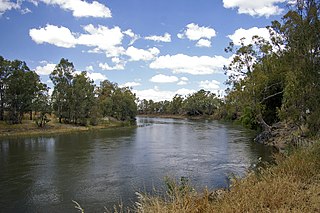
Back Murrumbidgee Afrikaans نهر موروبيدجي Arabic نهر موروبيدجى ARZ Марамбіджы Byelorussian Марамбіджы BE-X-OLD Марамбиджи Bulgarian মারাম্বিজি নদী Bengali/Bangla Riu Murrumbidgee Catalan Murrumbidgee River (suba sa Ostralya, State of New South Wales, lat -34,72, long 143,20) CEB Murrumbidgee Czech
| Murrumbidgee River | |
|---|---|
 Murrumbidgee River at Wagga Wagga | |
 The Murrumbidgee is a major tributary of the Murray River | |
| Etymology | Aboriginal Wiradjuri language: "big water"[1] |
| Nickname(s) | 'bidgee |
| Location | |
| Country | Australia |
| State/Territory | |
| IBRA | |
| Districts | |
| Municipalities | |
| Physical characteristics | |
| Source | Peppercorn Hill |
| • location | Snowy Mountains, NSW |
| • coordinates | 35°35′7″S 148°36′5″E / 35.58528°S 148.60139°E |
| • elevation | 1,560 m (5,120 ft) |
| Mouth | confluence with Murray River |
• location | near Boundary Bend, NSW/Vic |
• coordinates | 34°43′43″S 143°13′8″E / 34.72861°S 143.21889°E |
• elevation | 55 m (180 ft) |
| Length | 1,485 km (923 mi)[2] |
| Basin size | 84,917 km2 (32,787 sq mi) |
| Discharge | |
| • location | Wagga Wagga[3] |
| • average | 120 m3/s (4,200 cu ft/s)[3] |
| Discharge | |
| • location | Narrandera |
| • average | 105 m3/s (3,700 cu ft/s) |
| Discharge | |
| • location | Balranald |
| • average | 27 m3/s (950 cu ft/s) |
| Basin features | |
| River system | Murray River, Murray-Darling basin |
| Tributaries | |
| • left | Gudgenby River, Cotter River, Goodradigbee River, Tumut River |
| • right | Numeralla River, Bredbo River, Molonglo River, Yass River, Lachlan River |
| Reservoirs | Tantangara Reservoir, Lake Burrinjuck |
| [4][5] | |
The Murrumbidgee River (/mʌrəmˈbɪdʒi/[6]) is a major tributary of the Murray River within the Murray–Darling basin and the second longest river in Australia. It flows through the Australian state of New South Wales and the Australian Capital Territory, descending 1,500 metres (4,900 ft) over 1,485 kilometres (923 mi),[2] generally in a west-northwesterly direction from the foot of Peppercorn Hill in the Fiery Range of the Snowy Mountains towards its confluence with the Murray River near Boundary Bend.
The word Murrumbidgee or Marrambidya means "big water" in the Wiradjuri language, one of the local Australian Aboriginal languages.[7][8][1][9] The river itself flows through several traditional Aboriginal Australian lands, home to various Aboriginal peoples. In the Australian Capital Territory, the river is bordered by a narrow strip of land on each side; these are managed as the Murrumbidgee River Corridor (MRC).[10] This land includes many nature reserves, eight recreation reserves, a European heritage conservation zone and rural leases.
- ^ a b "Murrumbidgee River". Geographical Names Register (GNR) of NSW. Geographical Names Board of New South Wales. Retrieved 8 June 2008.
- ^ a b "Longest Rivers". Geoscience Australia. Australian Government. September 2008. Retrieved 18 March 2017.
- ^ a b Green, D (2011). Water resources and management overview: Murrumbidgee catchment (PDF). NSW Office of Water. p. 14. Archived from the original (PDF) on 17 April 2018. Retrieved 4 April 2016.
- ^ "Our Catchment". Murrumbidgee Catchment Management Authority. Government of New South Wales. 2013. Archived from the original on 27 January 2014. Retrieved 22 January 2013.
- ^ "Map of Murrumbidgee River". Bonzle.com. Retrieved 22 January 2013.
- ^ Macquarie ABC Dictionary. The Macquarie Library Pty Ltd. 2003. pp. 647, 853. ISBN 1-876429-37-2.
- ^ "Marrambidya Wetland". Visit Wagga. Retrieved 17 December 2021.
- ^ Booth, Alison (8 May 2021). "An affecting tale of dispossession". Canberra Times. Retrieved 17 December 2021.
- ^ Room, Adrian (2003). Placenames of the World. McFarland. p. 246. ISBN 0-7864-1814-1.
- ^ "Murrumbidgee River Corridor" (PDF). Territory & Municipal Services. Archived from the original (PDF) on 13 April 2015. Retrieved 23 January 2014.
© MMXXIII Rich X Search. We shall prevail. All rights reserved. Rich X Search